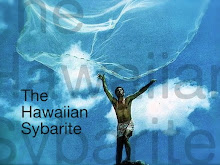
There's a special place in our hearts at The Hawaiian Sybarite for designer David Hicks, and we would like to think of him as a kindred spirit. The New York Times obituary for Hicks remarks that he was "[k]nown for his love of graphic color combinations as well as for a temperament that veered between disarming charm and apoplectic rage." We can only dream of having such praise lavished upon us after we've died.
Written by his son Ashley Hicks, "David Hicks: a life of design" is a richly-illustrated survey of the designer's career. Ashley Hicks has had unprecedented access to Hicks’ archives, personal photos, journals, and scrapbooks, and he has produced a monograph that leaves the reader with an understanding of the atmospheric, regal oases that Hicks spent his life working to create.

''My greatest contribution as an interior designer has been to show people how to use bold color mixtures, how to use patterned carpets, how to light rooms and how to mix old with new,'' Hicks himself wrote in his 1968 volume "David Hicks on Living—with Taste." His interiors were highly controlled and carefully considered, though Hicks was no minimalist. He stood outside of identifiable design-idioms and created the jet-set chic of the 1960s, with a clientele to match.
His interiors juxtaposed neoclassical antiques with Modernist furniture, Georgian and Victorian architecture with modern, geometric prints, all in a riotous color palette that often included shades that ranged from purple, maroon, crimson, magenta to the brightest pink. According to his wife, Lady Pamela Hicks, a glossy brown paint was eventually added to his palette after she began throwing glasses of Coca-Cola at him during moments of marital discord.
Hicks' outsized personality often overshadowed even his boldest work.
''He was an absolute volcano to live with, but so life enhancing,'' Lady Pamela said. ''I already miss his slamming of doors. David filled your sails with his enthusiasms. When I met him, I was visually blind, always with my nose in a book. He opened my eyes.''
His tantrums, his pedanticism, his domineering, his perfectionism, his his brilliant creativity, his love of grand gestures and passionate scenes and the operas of Richard Wagner—his affection for playing Wagner at ear-piercing volumes is legendary—none of these traits could have been excised.
Even after death, Hicks continued to exert his formidable power. He left epic instructions about for the disposition of his body in a document titled "The Demise of David Hicks." Among other final requests, the hearse was to be "a trailer pulled behind a Range Rover festooned with ivy," the funeral was to be held on Saturday at a 15th-century church near his home and his coffin was to be filled with his obituaries and press-notices.
David Hicks' confident refusal to follow anything but his own intuition created a style that often seems avant-garde today. He is remembered fondly by his design descendants, notably Kelly Werstler and Jonathan Adler, who draw on all periods, past and future, appreciate all design philosophies and use who don't hesitate to use all colors, just as David Hicks did generations earlier.
Hicks' detractors remind us that the patterned carpet lining the halls of the Overlook Hotel in Stanley Kubrick's "The Shining" is, in fact, Hicks' most famous pattern, "Hicks' Hexagon", and his connection with the dark, satanic energy that consumes Jack Torrance in the film is no coincidence. These same committed un-funsters often remind us also of Hicks' famous idolization of Richard Wagner and his famous love of Wagner's music, in specific his love of Wagner's marathon, six-hour apocalyptic opera Götterdämmerung. A person who likes Wagner is already suspected of being a dangerous sociopath, so their logic goes, and actually enjoying his operas, Götterdämmerung no less, simply proves the case that he was a talentless, degenerate pervert.

Maybe we shouldn't tell you this, but Götterdämmerung is our favorite opera, too.
"David Hicks: a life of design" from Rizzoli is available on Amazon.com and is available locally at Barnes & Noble Booksellers Ala Moana Mall, 1450 Ala Moana Blvd. Suite 1272, Honolulu Hawaiʻi, (808) 949-7307


No comments:
Post a Comment